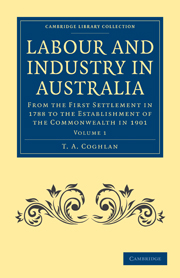 Labour and Industry in Australia
Labour and Industry in Australia Book contents
- Frontmatter
- PREFACE
- Contents
- PART I FROM THE FOUNDATION OF SETTLEMENT TO THE CROSSING OF THE MOUNTAINS
- PART II FROM THE CROSSING OF THE MOUNTAINS TO THE ABOLITION OF THE ASSIGNMENT SYSTEM
- I INTRODUCTION TO THE SECOND PERIOD
- II CONVICT LABOUR: ASSIGNMENT
- III FREE LABOUR
- IV IMMIGRATION
- V THE OCCUPATION OF LAND
- VI AGRICULTURAL AND PASTORAL PURSUITS
- VII THE CURRENCY
- VIII TRADE AND PRICES
- PART III FROM THE ABOLITION OF THE ASSIGNMENT SYSTEM TO THE DISCOVERY OF GOLD
- PART IV FROM THE DISCOVERY OF GOLD TO THE INTRODUCTION OF FREE SELECTION OF LAND BEFORE SURVEY
V - THE OCCUPATION OF LAND
Published online by Cambridge University Press: 05 August 2011
- Frontmatter
- PREFACE
- Contents
- PART I FROM THE FOUNDATION OF SETTLEMENT TO THE CROSSING OF THE MOUNTAINS
- PART II FROM THE CROSSING OF THE MOUNTAINS TO THE ABOLITION OF THE ASSIGNMENT SYSTEM
- I INTRODUCTION TO THE SECOND PERIOD
- II CONVICT LABOUR: ASSIGNMENT
- III FREE LABOUR
- IV IMMIGRATION
- V THE OCCUPATION OF LAND
- VI AGRICULTURAL AND PASTORAL PURSUITS
- VII THE CURRENCY
- VIII TRADE AND PRICES
- PART III FROM THE ABOLITION OF THE ASSIGNMENT SYSTEM TO THE DISCOVERY OF GOLD
- PART IV FROM THE DISCOVERY OF GOLD TO THE INTRODUCTION OF FREE SELECTION OF LAND BEFORE SURVEY
Summary
It was the pastoral industry which naturally received the first and greatest impulse from the crossing of the Blue Mountains. Much of the newly discovered country was open plain, free from timber and clothed with succulent grass and herbage, well watered, and in every respect suitable for depasturing stock on a large scale, and many of the settlers transferred themselves with their stock and other belongings to the Bathurst plains. In 1822, that is to say, shortly after the flocks had begun to make their appearance west of the mountains, the sheep in New South Wales did not exceed 139,000 all told; thenceforward the increase was extraordinary, the numbers doubling in little more than four years, and in large stock the increase was relatively as great. The demand for land was incessant, but the methods adopted of satisfying that demand were surprisingly inadequate.
Brisbane's original instructions in regard to the disposal of land were the same as those given to his predecessor. He was authorized to make grants of 30 acres or slightly more to ex-convicts, and grants of an additional 100 acres to other suitable settlers. Free settlers were beginning to arrive in considerable numbers, and to any of these who had a capital of more than £250 the Governor was authorized to make grants at the rate of one square mile of territory for every £500 immediately available for its cultivation—the maximum area allowed to one individual being 2560 acres.
- Type
- Chapter
- Information
- Labour and Industry in AustraliaFrom the First Settlement in 1788 to the Establishment of the Commonwealth in 1901, pp. 229 - 248Publisher: Cambridge University PressPrint publication year: 2011First published in: 1918


